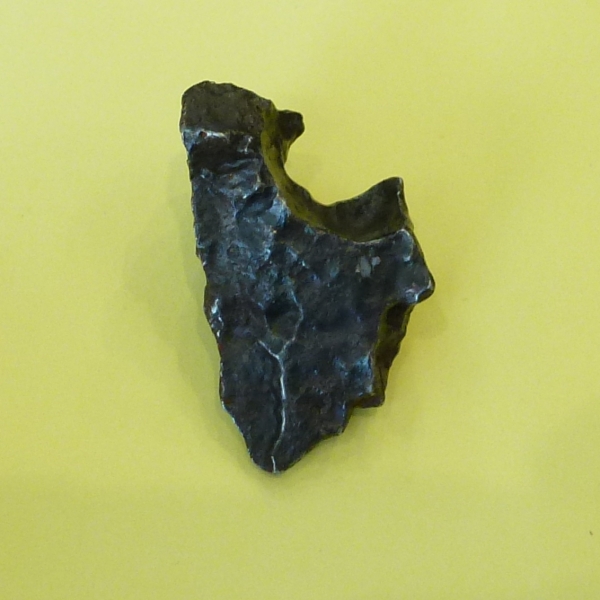No products in the cart.
Metal Specimens
SIBERIAN NICKEL IRON METEORITE
Availability:
Out of stock
SIBERIAN NICKEL IRON METEORITE
A lovely chunk of star dust in the form of a Siberian Nickel Iron Meteorite. This specimen originally came from outer space and fell to Earth on February 12 1947. IIB is the chemical classification for this meteorite which denotes this is the “Coarsest Octahedrite” with 5.7-6.4% Ni.
Location:
Sikhote Alin, Siberia (IIB)
Dimensions:
3.3cmx 1.5cm x 2cm, 22g.
Compare
SIBERIAN NICKEL IRON METEORITE

A lovely chunk of star dust in the form of a Siberian Nickel Iron Meteorite. This specimen originally came from outer space and fell to Earth on February 12 1947. IIB is the chemical classification for this meteorite which denotes this is the “Coarsest Octahedrite” with 5.7-6.4% Ni.
At the Cairo Museum in King Tutankhamun’s Tomb stash I saw a Meteoric Iron Knife. Ancient Man would have thought Meteorites to be a gift from the skies. Man made weapons like swords, knives, spears and arrow heads from meteorites. Natural iron is not necessarily “native” to Earth since it rarely occurs on the Earth’s surface by terrestrial processes. It is mostly found in the form of meteorites that have impacted the Earth’s surface. A few rare terrestrial gabbros and sulfide deposits do contain elemental iron-nickel deposits, these are the only truly native iron-nickel. All natural iron, whether it is native or meteoritic, is actually an alloy of iron and nickel. The two elements are combined in varying percentages from less than 6% nickel to as much as 75% nickel, although iron is by far more common than nickel.
Location:
Sikhote Alin, Russia (IIB).
Dimensions:
3.3cmx 1.5cm x 2cm, 22g.
SKU: MW7872 Category: Metal Specimens Tags: METEORITE, NICKEL IRON, NICKEL IRON METEORITE SIBERIA, SIBERIA
Related products
- Australian Minerals, Crystals, Galena, Metal Specimens, Minerals of the World, Pyrite
GALENA RHODONITE CRYSTALS
 Australian Minerals, Crystals, Galena, Metal Specimens, Minerals of the World, Pyrite
Australian Minerals, Crystals, Galena, Metal Specimens, Minerals of the World, PyriteGALENA RHODONITE CRYSTALS
Galena Rhodonite Crystals. A classic Aussie mineral & location, great as a specimen for display. Lovely colours and other interesting associated minerals, what looks like Pyrite. Galena showing great cubic crystal form with bright red Rhodonite. This specimen is mounted on a perspex pad for enhanced display.
Location:
Broken Hill, New South Wales, Australia.Dimensions:
10.5cm x 7.8cm x 9.1cm, 1108g.Rhodonite: MnSiO3.
Galena: PbS, Lead Sulfide.
SKU: n/a - Crystals, Galena, Metal Specimens, Minerals of the World, Pyrite
GALENA SPHALERITE CRYSTALS
GALENA SPHALERITE CRYSTALS
An interesting little specimen of Galena Sphalerite Crystals. The Galena appears in perfect crystal form, a triangle look for a cubic form element. Add great looking Sphalerite Crystals for a super piece! Recognisably Bulgarian in form and association.
Dimensions:
4.3cm x 1.9cm x 3.1cm, 43g.Location:
Madan ore fields, Bulgaria.Galena: PbS
Sphalerite: ZnS
SKU: MW7658 - Australian Minerals, Crystals, Gem Crystals, Metal Specimens, Minerals of the World, Top Shelf
GEMMY RHODONITE CRYSTALS
 Australian Minerals, Crystals, Gem Crystals, Metal Specimens, Minerals of the World, Top Shelf
Australian Minerals, Crystals, Gem Crystals, Metal Specimens, Minerals of the World, Top ShelfGEMMY RHODONITE CRYSTALS
A superb specimen of Gemmy Rhodonite Crystals in Galena. A cluster of chunky, red translucent crystals on matrix. This specimen in particular shows amazing crystal colour and shape and will make a worthy addition to any collection. Two main crystals one atop the other nested in Truncated Galena from Broken Hill.
Location:
Broken Hill, NSWDimensions:
3.7cm x 2.5cm x 2.2cm, 34g.Rhodonite: MnSiO3
Named in 1819 by Christoph Friedrich Jasche from the Greek rhodos or “rose”, referring to its colour.
Galena: PbS
Galena is the primary ore mineral of lead. Worked for its lead content as early as 3000 BC, it is found in ore veins with sphalerite, pyrite, chalcopyrite, tennantite-tetrahedrite, etc. and in skarns, as well as in sedimentary rocks where it may replace carbonate beds or be deposited in pore spaces.
Check out more Aussie minerals here.
SKU: AM23GRC01 - Crystals, Metal Specimens, Minerals of the World, Pyrite
PYRITE SUN LARGE
A broken Pyrite Sun Large. This is a natural formation of Pyrite and something quite different to the usual more cubic looking varieties. Striations radiate out from the centre. Our Suns are hand selected at the source for their excellent quality. We are well known for our metals range and have pyrite specimens showing cubic, orbicular and octahedral crystals, as well as these suns. Pyrite (“fools gold”) is popular with all age groups. A great piece for the collector of unusual pieces. This Pyrite Sun comes with a perspex stand for display and looks even better in person. Unfortunately this one was broken in the post but it is very large and would still be good as a display specimen for the collection. Could be used for making jewellery.
Dimensions:
12cm diameter, 267g.Location:
Sparta, Illinois, USA.PYRITE FeS2.
SKU: L0304 - Crystals, Galena, Metal Specimens, Minerals of the World, Quartz
GALENA QUARTZ 2
An interesting Galena Quartz 2 combo. Shiny crystals of Galena with Quartz Crystals on matrix. Start or add to your metals collection with a specimen from a premier location. Modified crystals radiating in a fin or fan formation, miner Calcite with a sprinkling of Chalcopyrite.
Dimensions:
12.2cm x 6.6cm x 5.8cm, 548g.Location:
Madan, Bulgaria.Galena:
PbS or (Pb,Ag,As,Sb,Cu)S.Quartz: SiO2.
SKU: MW8187-1














